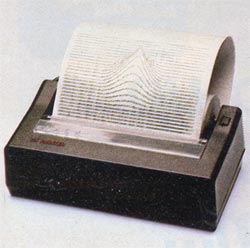|
ZX Printer
1981

 |
eBay
online auctions |
| Collectors frequently sell old Sinclair products
on eBay.co.uk.
Click the "GO" button on the left to find any Sinclair
joysticks being auctioned. |
|
| Best
search term: |
printer (zx,sinclair) -(timex,centronics,interface) |
| Availability:
|
Common |
| Typical
value: |
£15 |
| |
More
info on buying & selling Sinclair computers |
The ZX Printer, launched in
November 1981 at a price of £49.95, was Sinclair's typically
non-standard answer to the prayers of ZX81
(and, later, Spectrum)
owners who wanted a printer for their computer. In those days,
a good-quality printer could cost upwards of £250 or
more - in the ZX81's case, this would have been several times
the cost of the computer itself. Although it was possible
to connect a parallel-port ("Centronics") printer
to the ZX81 or Spectrum via third-party interfaces or Sinclair's
own Interface
1, in the case of the Spectrum, there was clearly
a market for a budget alternative. The ZX Printer fit this
niche well; it was a popular product and sold tens of thousands
of units.
 The
design of the ZX Printer was heavily influenced by similar
devices available at the time in the United States. It was
never intended for word processing purposes, instead being
aimed at users who wanted to obtain program listings for reference
purposes. The printer used black paper coated with aluminium
and printed 32 characters to a line. Two styli were mounted
on a belt which moved across the paper. An electric charge
was passed through the styli, burning away the aluminium coating
to reveal the black paper underneath in the shape of the appropriate
character. This ingenious approach gave clear if slightly
ragged results, but unfortunately the machine itself was not
very robust - the print quality rapidly deteriorated with
use. For that reason there are not many well-functioning ZX
Printer still around today. The
design of the ZX Printer was heavily influenced by similar
devices available at the time in the United States. It was
never intended for word processing purposes, instead being
aimed at users who wanted to obtain program listings for reference
purposes. The printer used black paper coated with aluminium
and printed 32 characters to a line. Two styli were mounted
on a belt which moved across the paper. An electric charge
was passed through the styli, burning away the aluminium coating
to reveal the black paper underneath in the shape of the appropriate
character. This ingenious approach gave clear if slightly
ragged results, but unfortunately the machine itself was not
very robust - the print quality rapidly deteriorated with
use. For that reason there are not many well-functioning ZX
Printer still around today.
The electrostatic paper itself is also problematic in use.
These days it is difficult to find suitable paper, and even
back in the early 1981 the limitations of the paper were very
apparent. The aluminium surface is very delicate and skin
oils rapidly degrade it, making it very easy to leave fingerprints
all over a pristine printout. It also fades over time. The
solution, surprisingly, was to photocopy it. This was how
the program listings which were a standard feature of Sinclair
magazines were produced - via photocopies of ZX printer output.
A rebadged version of the ZX Printer was available from Timex
in the United States as the TS
2040.

Back
to top
© Chris Owen 1994-2003
|